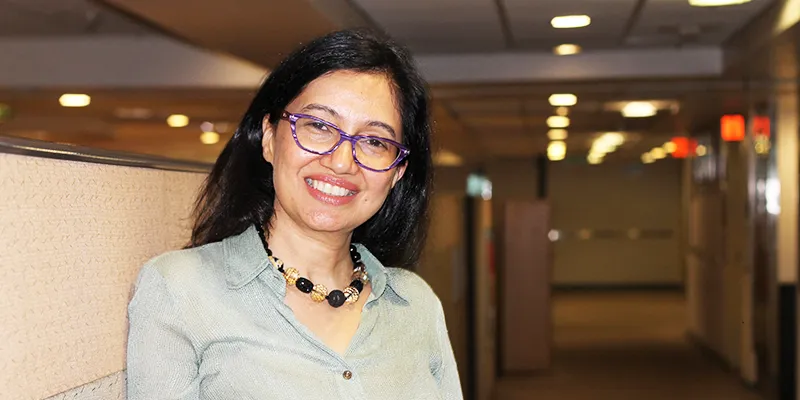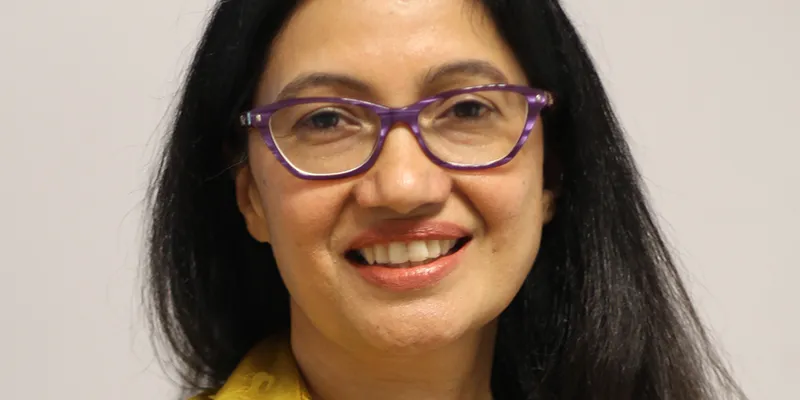I don’t have to wear grey to show grey matter: Nivruti Rai, GM, Intel India
Khudi ko kar buland itna ki har taqdeer se pehle
Khuda bandeh se yeh khud puchey
Bata teri raza kya hai?
This is what Nivruti Rai, General Manager, Intel India and VP, Platform Engineering Group, Intel Corp, recites in the same breath that she explains to me the difference between analog and digital engineering.
Her love for Urdu comes from childhood years spent in Delhi and Lucknow and her technical knowledge from her time at Oregon State University, where she was one of two women in a class of 70 engineering students.
Her love for her first job was such that she has stuck around for 22 years, working mostly from Oregon, USA, and Bengaluru. “If a woman joins Intel, in 22 years, she comes out looking like me,” she smiles.
Working from two countries, she has managed teams across the globe and climbed up the ladder to create value for Intel India and the Indian ecosystem on the whole.

In the past two decades, some things have remained constant in her life, be it starting her days with tea and the crossword or, going deeper, her thirst for knowledge, excitement for technology and invention, and love for fashion. In a freewheeling chat with YourStory, she shares her likes, dislikes, journey with Intel, and why collective intelligence is the key to innovation. Read on for more:
Creating value — collective intelligence and partnership
David Bruce Audretsch, an American economist whose work I read, claims that innovation, policy, and entrepreneurship are key for the growth of a country’s GDP or an organisation’s revenue. As I subscribe to this thought, I am trying to leverage all three.
According to statistics, Israel has a population of eight million, same as Bengaluru, and it sees five startups emerge every day, while our entire country sees the emergence of five. In India, we have the scope to do more. At Intel, we have incubated 17 startups within the last one year. We have a Maker Lab, and since we know that hardware is tough and expensive, we are investing in such labs so companies can leverage our hardware and other resources to build startups. Software alone can’t generate the revenues and GDP we are looking for.
Engineering is a part of my role but managing and creating more value out of Intel India and India, on the whole, is my additional responsibility. How can I help to create leaders in India who can drive the global economy? Here I believe in collective intelligence. What does collective intelligence mean? It means that if there are four people in this room, our shared intelligence is greater than that of any one of us.
I partner with the government, startup community, and other MNCs to create value through this collective intelligence.
22 years and counting
I joined Intel in 1994 as a young Recent College Graduate and I love my engineering role to the extent that I tell people that I can do it in my sleep. It all started while I was doing my PhD and my husband was working with Intel. One of those days, I walked into Intel Oregon with my guest badge to meet him. By the time I left, I dreamt of working for this company someday.

A story my mentor from my initial years at Intel shared with me has stayed with me. He said people come and join an organisation because they have this education and are looking to get a job to earn money. They stay on for a few more years to build a career, but loyalty is built from the calling of the heart. You have to inspire people so that it touches their hearts and that is when loyalty kicks in. I was given so many wonderful opportunities, I had managers who helped me, so many people that touched my heart, showed the value that Intel had and could create in the lives of people.
Intel is a company that has driven honest invention since its inception. In my opinion, innovation can be done by many — good examples are Facebook, Google, and Apple. Everyone, however, cannot do invention — innovation is about creating value and generating something new, while invention is when you are defying scientific phenomena. I have seen the latter happen at Intel and it has never failed to give me a high.
Leadership challenges
I have managed teams in Costa Rica, Israel, Malaysia, the USA, and India. Each of these countries has had a different culture and mindset. For example, in Israel, initially, I felt everyone was rude to me but soon I realised that I was supposed to interrupt and speak loudly to be heard. It was the way things worked. In Malaysia, people were soft-spoken. They hardly talked, so I had to gather everyone and ensure that the collective intelligence I so value was taken into account.
When I moved to India from the US in 2005, my biggest challenge was to grasp whether people were taking up a task because they had the bandwidth or the skill for it or just because you have to say yes to everything in India.
In a hierarchical culture like ours where the emphasis is upon respecting elders and parents or managers, if an employee says yes even when she or he does not have the bandwidth or skill, it impacts their other deliverables, and if they don’t have the skill, they end up with an average job at best. Hence, as a manager, it was my biggest challenge to understand whether they were really good or just saying yes.
Team building
I really believe in the strength of collective intelligence. For me, it is really important to rally as many people as possible. I work with a lot of millennials and think that diversity inclusion — be it in terms of experience, age, or geography — brings in so much value but sometimes we ignore it.
In my early years at Intel, my mentor of three years told me that the best leader is the one who makes leaders, not followers. I have done that too. The idea is to make the people who work with you so strong that they don’t toe the line but use their intellect to present ideas even if they go against you.
A good team has to have both EQ and IQ. As regards IQ, I have imbibed Peter Drucker’s philosophy that two things — innovation and marketing — impact a business, person, or country. All else is cost.
We love innovation, but what we often forget is marketing. In India, parents tell children, “Don’t thump your chest and praise yourself.” That is why most people here do not tom-tom about themselves at the workplace. But if you don’t talk, how will people know what you are doing? Jungle mein more nacha, kisne dekha? What is the point of doing something well if there is no one around to appreciate it?
A leader drives the team and hence, to drive innovation, the leader needs passion and initiative. If I don’t believe in something 200 percent, I won’t have the passion to convince others; instead, my lack of passion will inadvertently even rub off on others.
Women in tech — perception management
One of the basic challenges women in tech face, whether in India or the US, is that of perception.
The first is that if a woman is well dressed, she is not smart. The assumption is that the well-dressed woman will show a few graphs and Excel sheets but won’t really know much about engineering. I have seen this happen in all the countries I have worked in.

I have walked into meetings and rooms where I have been perceived as dumb because I have been smartly dressed till the audience realised I am an analog engineer and can more than talk tech. That’s when they have realised they are wrong. I don’t believe I have to dress grey to show grey.
The second perception is that being a woman, I must be emotional and incapable of taking feedback.
Also, there are not very many women in tech. Over my 22 years of growing up at Intel, I would often be the only woman in a big conference room. Initially, I would be very embarrassed by the language and would turn red but over the years I built a thick skin.
If you throw a human being in the water, if the person does not die then he/she builds up gills over the years. My team does analog design, so along with managing voltage level we built something called a transceiver, which takes and gives signal. Over the years, the transceiver I built in my ear would filter out things that I did not want to hear or did not want to internalise.
You can have it all
I was the third girl child of my parents, and my extended family had a field day expressing regret over my birth, something I only found out when I was 12, for my grandmother and mother, both very strong women, had since childhood instilled in me the feeling that I could be whoever I wanted. Both these women have been my inspiration and pillars of support.
My husband is very supportive but also someone with whom I have the most interesting exchanges. We both expand each other’s horizons — we share whatever we read and learn with each other. I tell him about innovations and inventions and he shares what he is reading, say, innovations in archaeology.
I am a voracious reader. My other loves are cooking and fashion, and I design my own sarees. I know what I like and want and I don’t compromise on it. I can have it and so can you if you really know what you want. All you have to do is set your priorities right.
The freedom to drive innovation
Intel has reinvented itself multiple times. We have moved from microprocessors to platforms and connectivity, and now the entire industry is going through the revolution of the Internet of Things where things are connected at all levels.
We talked about AI for so long and now we are seeing it put to use in robots, machines, etc. Intel is betting heavy on saying that in the future, starting now, things will be so connected. Our machines will be talking to each other and that is the direction we have to work towards.
Intel is an exciting place to invent and innovate. The freedom I have to drive innovation given that I am such a big risk-taker makes it so valuable. I can touch people’s lives through technology and make things different for them. That is a high I love and it keeps me running every day at Intel.







